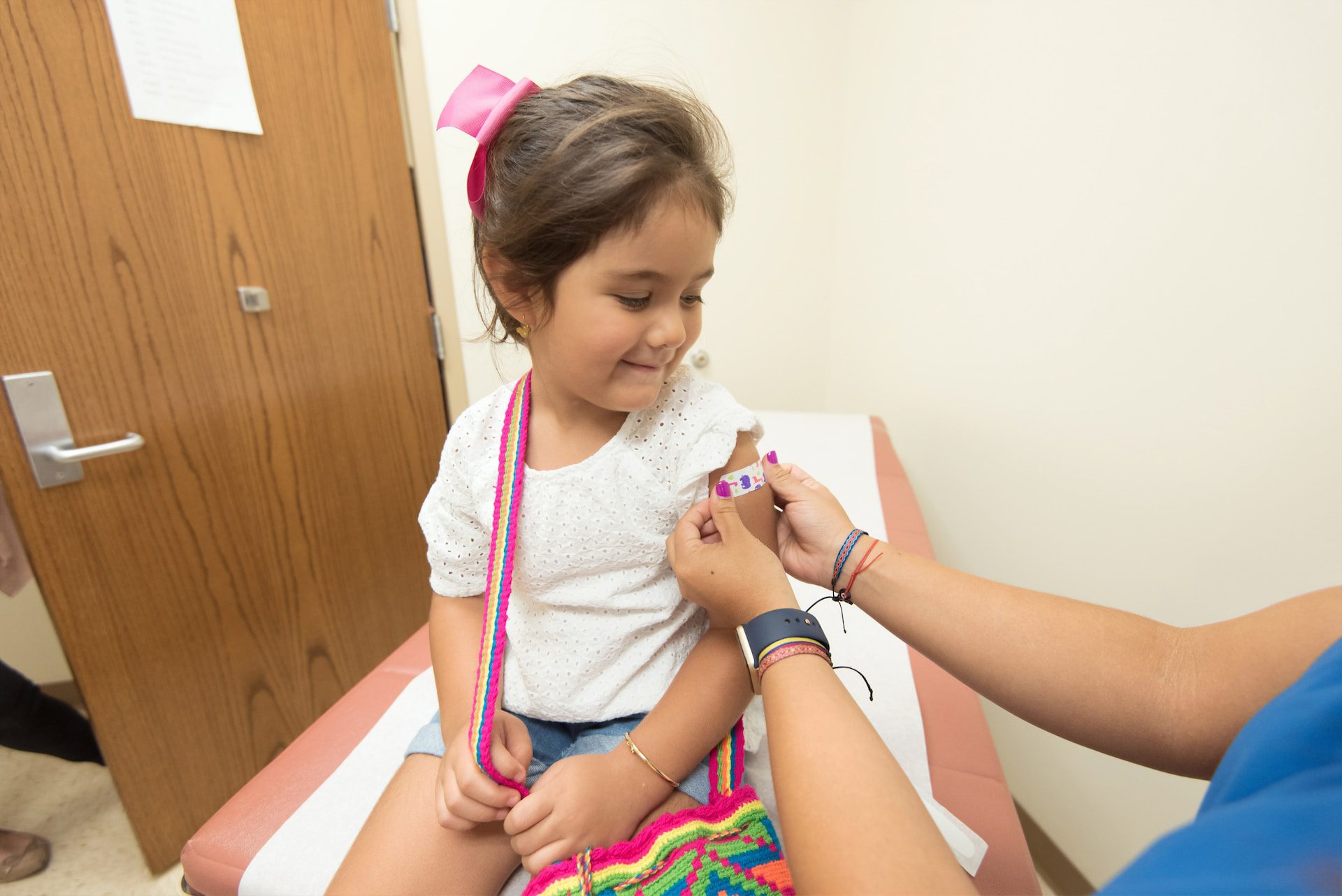Your child has probably heard about Coronavirus by now and may have some worries. They may also already have heard about “a vaccine” but not know what this is.
The following anxiety-reducing method is appropriate not just for the COVID-19 vaccine but can help with all vaccines (immunisations) administered by a needle, such as Influenza, Diptheria, Tetanus, Pertussis (whooping cough), meningococcus etc.
It’s the “Not Knowing” that makes things scary for kids. So, I’ve made a 5-step breakdown of how to explain having a vaccine to your child.
Each step has a separate main point that you want to get across to your child. Following each step, in order, allows a natural flow to the discussion and gives your child the chance to voice concerns or ask questions.
I’ve written the discussion exactly as you might say it, in this font. This approach worked for my kids from about age 3 onwards. The younger the child, the simpler your language will be:
Step 1 – You need to have an injection
There’s a virus in the world called Coronavirus, or COVID, which can make people very sick.
But we now have medicines to stop people from getting sick, even if they catch the virus.
There is a special medicine called a vaccine.
It’s a tiny injection that stops you from getting sick, even if you catch the Coronavirus.
Pretty handy hey?!
Then PAUSE and see if your child asks any questions.
If your child doesn’t know what an injection is:
It’s a very thin needle that goes this far (hold your thumb and index finger 1 cm apart) in your arm for about 3 seconds to give the medicine to your body.
The focus in on how this vaccine prevents serious illness, but your child will by now be thinking about the injection. So here is the next step.
Step 2 – You can do this! You’ve already had loads of injections
Do you know you’ve already had heaps of injections? (At this point I like to bring out their immunisation record for them to hold, and we look at it together).
You had an injection when you were born.
Then you had more when you were 2 months old, 4 months old, 6 months old, 1 year old, 1 ½ year old, and 4 years old!
You’ve had heaps – and you were super brave for all of them!
At this point, your child may want to count up the number of injections they have had. They may also be very interested in how they went with all these injections. This is a great time to follow your child’s lead, as well as reflect on those experiences (which they probably won’t remember).
Step 3 – Reflect on previous injection experiences
If your child asks how they went previously:
Well, you cried when you were a baby.
You were too little for me to explain what would happen, so it was a big shock.
But as you got older, you got braver and braver. Sometimes you cried a bit, but you sat on my lap and had a big cuddle and it was over really quickly.
One time, they blew bubbles and distracted you, and you hardly even noticed!
Depending on how playful your child is feeling, you might show them what happened (a bit like the Bluey “Doctors” episode):
When you were little the injection was like this (poke them gently in the thigh and say) “Sting!” right here in your thigh! (Why? Because that was your chubbiest bit!).
Step 4 – Be honest. It will hurt, but not much.
This time, now you’re big, you will have the injection in your arm.
You will feel the needle (Yes, it IS a needle, no need to make a big deal of it), but you’ve had heaps of ouchier things. (Your child may think of all the pains they’ve had before – this is very helpful because you can then relate this vaccine to their previous experiences.)
If your child doesn’t bring up previous pains:
It will sting more than a mozzie bite but will hurt a lot less than falling off your bike and way less than a bee sting.
And the sting only lasts for about 5 seconds, maybe less. (Then count 5 seconds together)
- Be ready to have the conversation about how much it will hurt more than once. Reassure your child every time that they will feel it, but that it is far less painful than so many other experiences they’ve already had.
- NOTE: “It will hurt a bit, but I know you’ll be ok” will be more reassuring than “you’ll be fine”.
Step 5 – Explain the practicalities
For this part, the amount of detail you give will depend on your child’s age and how much they want to know. Feel free to bring this down to the key steps of: when it is (day), how you will get there, and who will be with them the whole time.
For those with kids who want to know everything, here it is (but you might break this up a lot with discussion along the way).
We are going to get the vaccine on Thursday.
That’s 2 sleeps away.
We will go by car.
After we park the car, we will put on our masks and go into the vaccination centre/pharmacy.
There will probably be a queue.
They might ask us to use the hand sanitiser and will take our temperature.
Then they check our details and show us how to get to the nurse’s station.
You will sit on my lap, like this (practice child sitting on your lap, side on, and take the opportunity to give them a sneaky hug).
The nurse will give you the injection (Sting!) and I’ll give you a big hug.
After the injection we sit in a waiting area for 15 minutes, just to check you are ok.
Then, we can go home.
Your arm might be a bit achy that night, or it might be fine.
When we get to the car/ home …(Insert your treat here.
For my kids, I said: We will take the iPad and you can watch TV all the way home.)
If you want to set it out as dot points or make a visual plan (you can use the visual planning tool within the Courageous Kids app) here are the 10 steps involved. when you go to a vaccination hub:
10 steps when you go to a vaccination hub:
- Follow the entry signs
- Hand sanitiser
- Join the queue
- Temperature Check
- Check-in
- You might get a treat (fidget spinners)
- Await your vaccine station (there was a 9 ¾)
- Meet your nurse & Get VAXXED!
- Wait 15 min for obs – this is a good time for a cuddle.
- Go home!!
Final Thoughts
If you can see that your child is still worried, ASK them which part is worrying them the most. After you have addressed the first worry, ask if they have any other worries. You may need this conversation, or parts of it, more than once.
Do not be surprised if your child later asks…but why do I have to have it? Or but how does it work?
Don’t worry. My blogs on But WHY do I need it? And How does it work? Are coming soon!


